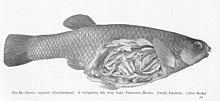Livebearers

As a live-bearing fish is called the fish species in which the eggs in the womb develop into juvenile fish. While the eggs are being laid by the female, the fry burst their egg shell and are immediately able to swim. The fish that give birth to their young alive include many half-bills , highland parsons , and viviparous toothcarps (including popular aquarium fish such as guppies , mollys, and swordtails ), as well as many sharks and rays . Since internal fertilization is required in livebearers, mating takes place .
The development of fry in the womb is not comparable to that of embryos in mammals . In contrast to mammals, there is no placenta or umbilical cord . Only in the highland carp there is an umbilical cord-like connection between the embryos and the maternal tissue.
Due to the live birth, the young fish have already reached a relatively advanced stage of development. As a result, you are less exposed to enemies. Immediately after birth, they look for hiding places, such as slender aquatic plants.
See also
- Viviparity (= viviparous)